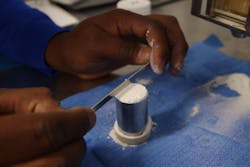Powder density: The importance of knowing your material before blending
Material properties are significant when it comes to choosing a blender that will achieve precise and consistent outcomes, which are vital in industries such as pharmaceuticals, chemicals, and food processing. Whatever the number of components in your powder blend, it is important to know the density, particle shape, moisture content, and other physical characteristics that might affect the blend before pushing the start button on the blender.
Consistent homogeneity of powder mixtures ensures stable quality, texture and other desirable properties. Successful blending begins with careful powder characterization and an understanding of the criteria that may impact the overall blend. Knowing the powder’s characteristics allows manufacturers to anticipate and correct any potential issues before they can negatively affect the blend.
Material density and blending
Knowing the density of the material is key and the first step to effective blending. Misconceptions regarding the relationship between density and weight are common, but density (mass density) represents the concentration of a substance within a specific volume.1
The apparent density, expressed in grams per cubic centimeter, represents the weight of a unit volume of loose powder. Apparent density holds significant importance for various processing parameters, such as compaction tooling design and press motion requirements. Apparent density is influenced by factors such as material density, particle size, size distribution, shape, surface area, roughness, and particle arrangement. Typically, decreasing particle size decreases apparent density due to increased friction and a larger specific surface area, though this is not always true for spherical powders with low friction. Controlling the apparent density within narrow limits is critical to ensuring consistent and reliable compaction outcomes in industrial processes.2
When loading a blender with numerous components and a significant quantity of material, density, accurate formulation, and load levels are crucial. This requires careful planning, assessment of machine capabilities, estimation or approximation based on available information, trial testing, and vigilant monitoring. By adhering to these steps, manufacturers can mitigate risks and increase the likelihood of obtaining the desired outcomes.
The physical properties of a blend’s components also impact the blend’s tendency to segregate or mix effectively. Powders tend to segregate due to factors such as variations in particle size, density, form and durability. Blend components combine and maintain equilibrium between the mixing and demixing phases better when particles have identical size, shape, and density.3 By understanding these physical properties, scientists and engineers can gain valuable insights into the material’s behavior during blending and other processes, enabling them to optimize the formulation, mitigate segregation issues, and achieve the desired material characteristics.4
Measuring material density
Manufacturers often struggle to determine the density of their materials. This lack of awareness can severely impact the blender loading process, resulting in inaccurate formulations and compromised batch quality.
A simple density test kit, such as the one shown in Figure 2, enables manufacturers to accurately measure their materials' densities. These test kits offer a convenient and reliable method for gathering essential data before beginning the blending process. There are also laboratories on the market that perform material density analyses by testing samples for customers. Giving manufacturers a thorough understanding of material density enables them to improve their blending procedures, address any problems, and reliably achieve the target batch quality.
If you do not know your powders, you can develop problems. And you won't be able to identify the source of the issue or understand the impacts of changes in your material's physical properties. For manufacturers dedicated to creating the ideal mix, the only alternative is to always have full powder characterization for the mix formulation.
References
- How to Calculate Composite Density | Sciencing
- Bulk Properties of Powders (nist.gov)
- first-page-pdf (sciencedirect.com)
- Effect of powder densities, particle size and shape on mixture quality of binary food powder mixtures - ScienceDirect
Advanced Powder Solutions
About the Author

George Paffendorf
Vice president of operations at Advanced Powder Solutions
George Paffendorf is vice president of operations at Advanced Powder Solutions, which specializes in the development and optimization of powders across a range of industries, including pharmaceuticals, cosmetics, flavors & fragrances, nutraceuticals, additive manufacturing, plastics, food & beverage, and more.


